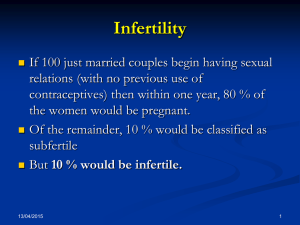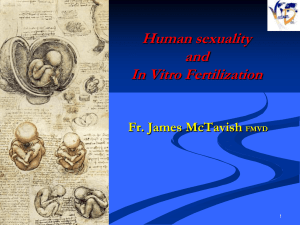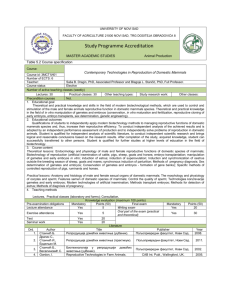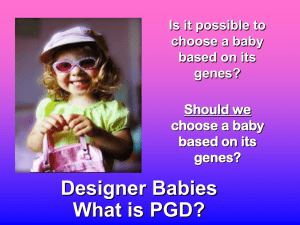File
advertisement
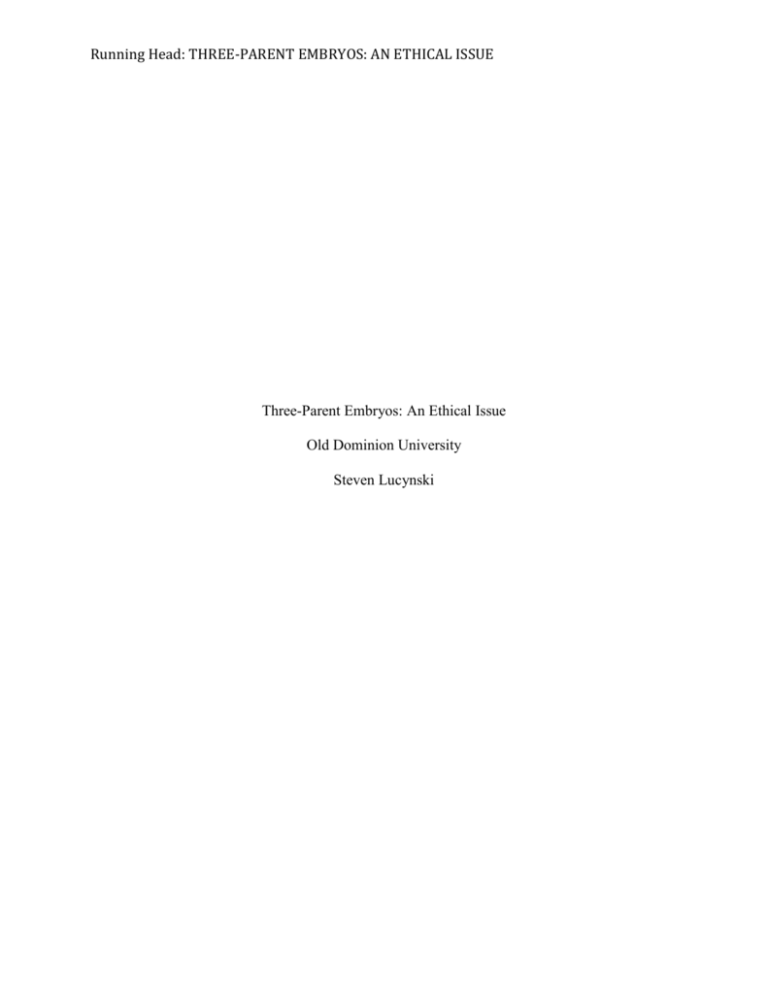
Running Head: THREE-PARENT EMBRYOS: AN ETHICAL ISSUE Three-Parent Embryos: An Ethical Issue Old Dominion University Steven Lucynski THREE-PARENT EMBRYOS: AN ETHICAL ISSUE 2 Three-Parent Embryos: An Ethical Issue The purpose of this assignment is for the student nurse to identify, describe and discuss a publicly debated women’s health, obstetric or neonatal issue. Pertinent background information will be presented. The student nurse will identify his/her intended audience. Opposing sides of three-parent embryos will have their arguments presented. Intended Audience The possibility of the creation of a three-parent embryo impacts the entire human race. This technology could be used to eradicate debilitating diseases and create designer babies. However, the primary audiences for this paper are parents who refrain from having children because of a genetic disease, healthcare providers, healthcare students and any other population that could benefit from a synopsis of a new obstetric issue. This paper can benefit parents who refrain from having children because of a genetic disease by educating them. This paper will provide a detailed comparison of the opposing sides of three-parent embryos. Healthcare professionals will benefit from this literature by staying up-to-date with current obstetric ethical issues. Genetics, Inherited Disease and In Vitro Fertilization Prior to discussing three-parent embryos, basic knowledge on human genetics and mitochondrial disease is essential. Genetics is a term that is used to describe the science concerning general mechanisms of heredity and variations of inherited genes. Genes are the blueprints or instructions for all substances in the human body. Every human cell, that contains a nucleus, contains an entire set of genes and mitochondria. A complete set of genes is called the genome. The human genomes contains between 20,000 and 25,000 genes. Mitochondria are THREE-PARENT EMBRYOS: AN ETHICAL ISSUE 3 responsible for providing energy and are often referred to as the “powerhouse” of the human cell (Ignatavicius & Workman, 2013). The human genome is expressed through our deoxyribonucleic acid (DNA) found inside the nucleus of a human cell. Through the human genome project, the human genome was mapped or identified. This allowed scientists to create a template for gene comparisons. When a person has a different sequence of genes from the human genome template, they are considered to have a mutation. Mutations are changes in DNA that can have deadly implications. DNA is inherited. DNA and genes are passed down from generation to generation. Mitochondrial disease is a specific group of conditions that affect mitochondria through mutations of DNA (Allan & Finnerty, 2007). In in vitro fertilization (IVF), a women’s egg is fertilized by a man’s sperm outside of the woman’s body. This process was first successfully completed in 1978 by Robert G. Edwards. A couple, the Browns, had been trying to conceive for nine years. Mrs. Brown had blocked fallopian tubes. Edwards consulted the couple and described IVF to them. They agreed to the procedure and pioneered IVF. Louise Brown, the first test tube baby, was the result. IVF is used today to manage infertility. IVF is utilized in the three-parent embryo (Allan & Finnerty, 2007). Three-Parent Embryos The Federal Drug and Food Administration (FDA) is considering pioneering an IVF technique that utilizes the DNA from three parents to circumvent debilitating diseases. For example, muscular dystrophy and certain respiratory problems are inherited mutations that could be prevented from a three-parent embryo. Mitochondrial disease is a specific group of conditions that affect the mitochondria through mutations of DNA. Mitochondrial DNA is strictly inherited from the mother. In the three-parent embryo, mutated mitochondrial DNA from the mother THREE-PARENT EMBRYOS: AN ETHICAL ISSUE 4 would be replaced by healthy DNA from another woman. The father’s DNA would not be changed. Thus, three individuals’ DNA would be used to create a single healthy newborn (Codier & Codier, 2014). With advances in technology, geneticists can identify problematic genes. Healthy parents can be unknown carriers of these problems. Genetic testing is recommended during prenatal care. Parents, specifically the mother, have the option of foregoing the genetic tests. Once the laboratory completes the tests, results are interpreted by a geneticist. The geneticist then explains the results to the parents and provides recommendations (Ignatavicius & Workman, 2013). Proponents of Three-Parent Embryos’ Perspective Proponents of three-parent embryos argue that this technique will allow parents to have healthy children when previously unable. As mentioned earlier, mitochondrial DNA is inherited directly from the mother. A three-person embryo could circumvent mitochondrial disorders such as Leber’s hereditary optic neuropathy and Leigh syndrome. Mitochondrial diseases can progress to heart and liver failure. Proponents feel so passionately about this technique because they believe it will save thousands of lives. One in 6,500 babies in the United Kingdom is born with a mitochondrial disorder. Their government is also considering three-parent embryos (Codier & Codier, 2014). Proponents assert this technique is ethical. A stem cell expert says, “Genes aren’t altered in the technique.” Proponents believe this IVF technique is a treatment and in no way genetic engineering. Susan Solomon, the director of the New York Stem Cell Foundation, says, “We’re just allowing [the embryo] to grow in an environment that isn’t sick. There is no genetic engineering. It isn’t a slippery slope.” The New York Stem Cell Foundation helped developed THREE-PARENT EMBRYOS: AN ETHICAL ISSUE 5 the technique with Columbia University researchers. Finally, proponents of three-parent embryos argue that the process is ethical because the outcome of the procedure is a healthy newborn (Codier & Codier, 2014). Opponents of Three-Parent Embryos’ Perspective Opponents of three-parent embryos argue that this technique is a slippery slope that will lead to genetic engineering and designer babies. In genetic engineering, specific desirable genes are selected and implanted into the embryos. Examples of desirable genes include blue eyes, tallness and intelligence. These babies are considered designer babies. Opponents suggest once we alter the mitochondrial DNA, the temptation to “improve” DNA by adding superior traits will be too strong to resist (Codier & Codier, 2014). Opponents argue that this process has never been completed before. They suggest there are implications and risks that have not been considered. Another negative aspect to consider is the inherent concerns associated with IVF. IVF is expensive and not without its own risks and ethical dilemmas. Some conditions patients’ receiving IVF have a risk for developing include: injury to internal organs surrounding the ovaries, infection and ovarian hyperstimulation syndrome. IVF is provided to patients on their own accord. Autonomy is encouraged in the medical world but not all populations believe in autonomy. It is a delicate, religious topic that concerns reproduction. Some opponents consider three-parent children unnatural (American Society for Reproductive Medicine, 2012). Summary Three-parent embryos are a current, sensitive obstetric ethical issue. A three-parent child has never been conceived. The technique to allow this is being developed in the United States and United Kingdom. Their respective governments are considering clinical trials. Proponents THREE-PARENT EMBRYOS: AN ETHICAL ISSUE believe three-parent embryos can be used to treat mitochondrial disorders. Opponents believe three-parent embryos have specific ethical and religious concerns. They are also concerned this technique will lead to genetic engineering. I have enjoyed this assignment. I learned a great deal about in vitro fertilization. IVF alone is an ethical issue; however, I was able to familiarize myself with the overall process and procedure. Mitochondrial DNA was something completely new me. I hadn’t previously considered DNA coding for even the smallest internal structures like the mitochondria. This assignment also provided me with the opportunity to review genetics, anatomy and microbiology. Prior to researching for this paper, I had never heard of the possibility of threeparent embryo. The technology needed to remove a nucleus from a cell and replace it is extremely advanced. I am fascinated by the possibility of removing crippling diseases. 6 THREE-PARENT EMBRYOS: AN ETHICAL ISSUE References Allan, H., & Finnerty, G. (2007). The practice gap in the care of women following successful infertility treatments: Unasked research questions in midwifery and nursing. Human Fertility, 10(2), 99-104. doi:10.1080/1464727060105032 American Society for Reproductive Medicine. (2012). Risks of In Vitro Fertilization. Retrieved from: http://www.asrm.org/FACTSHEET_Risks_of_In_Vitro_Fertilization/ Codier, E., & Codier, D. (2014). Understanding mitochondrial disease and goals for its treatment. British Journal Of Nursing, 23(5), 254-258 Davidson, M., London, M., & Ladewig, P. (2012). Olds' Maternal-Newborn Nursing & Women's Health Across the Lifespan (9th ed.). Upper Saddle River, NJ: Pearson. Ignatavicius, & Workman., (2013). Medical-Surgical Nursing Patient-Centered Collaborative Care (7tth ed., pp. 838). St. Louis, MO: Elsevier. 7 THREE-PARENT EMBRYOS: AN ETHICAL ISSUE 8 Honor Pledge "I pledge to support the Honor System of Old Dominion University. I will refrain from any form of academic dishonesty or deception, such as cheating or plagiarism. I am aware that as a member of the academic community, it is my responsibility to turn in all suspected violators of the Honor Code. I will report to a hearing if summoned." 4/18/14, Steven Lucynski 9 THREE-PARENT EMBRYOS: AN ETHICAL ISSUE CONTENT A. Introduce the issue: what caused it and what prompted past and present interest and concern. B. Identify who is interested in it and why, eg., who is your audience? C. Examine the opposing positions on the issue—to include the usual reasons cited to establish the validity of each perspective. Clearly delineate each side. Summarization to include a reflection of what you have learned from doing this paper. D. Minimum of one recent nursing journal used and a second related journal used for validation. POINTS POSSIBLE 15 15 30 20 E. Correct APA format. 10 F. Grammar, spelling and logical transitions. 10 TOTAL POINTS POSSIBLE 100 COMMENTS POINTS


